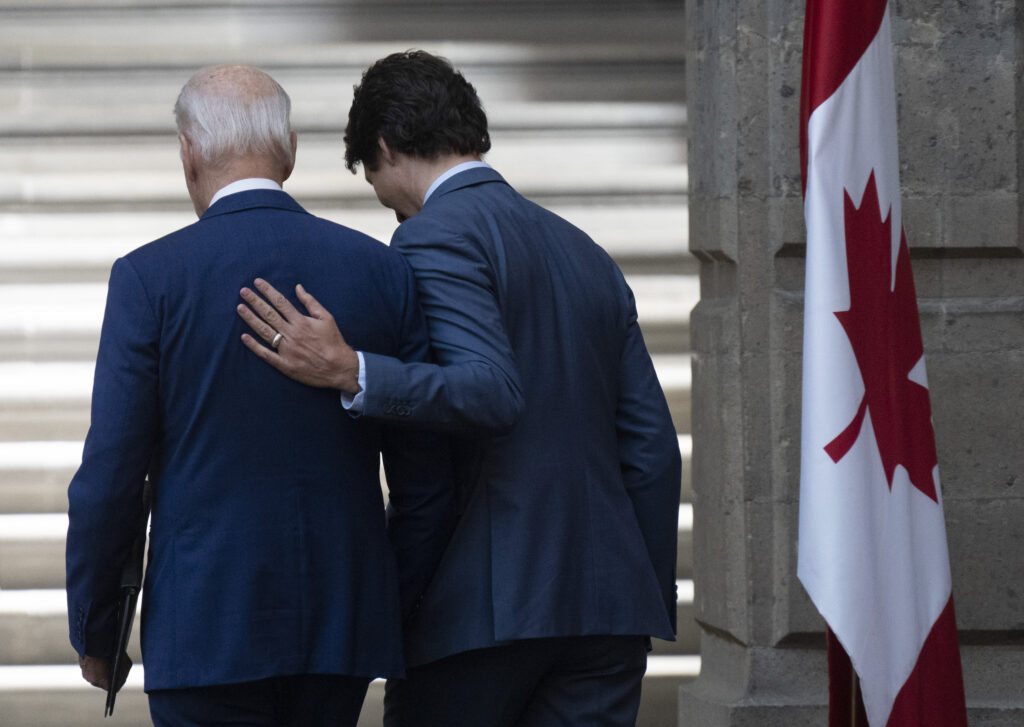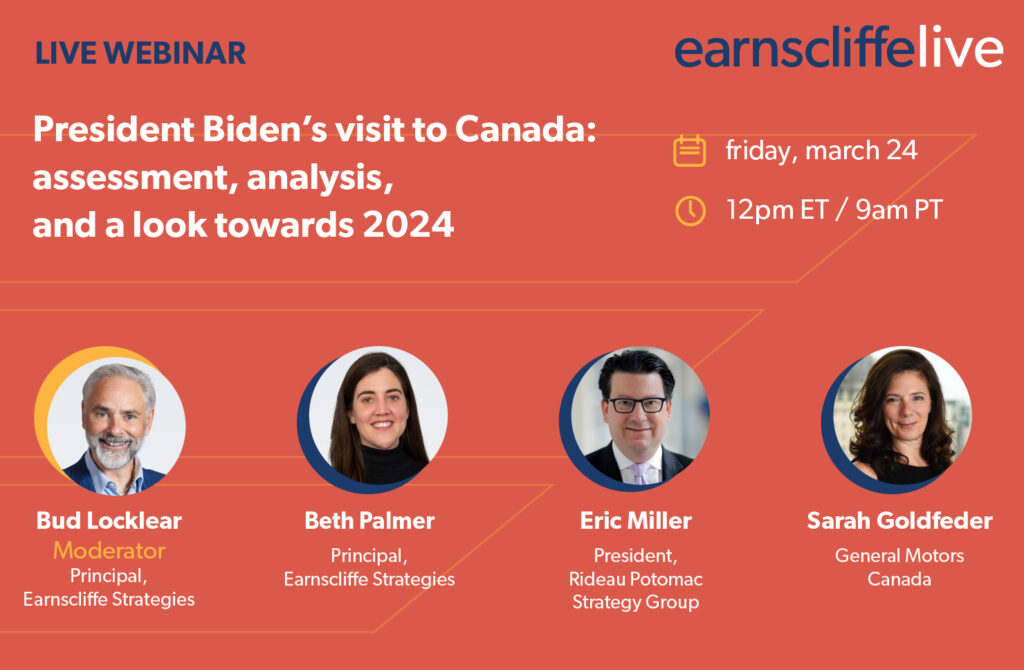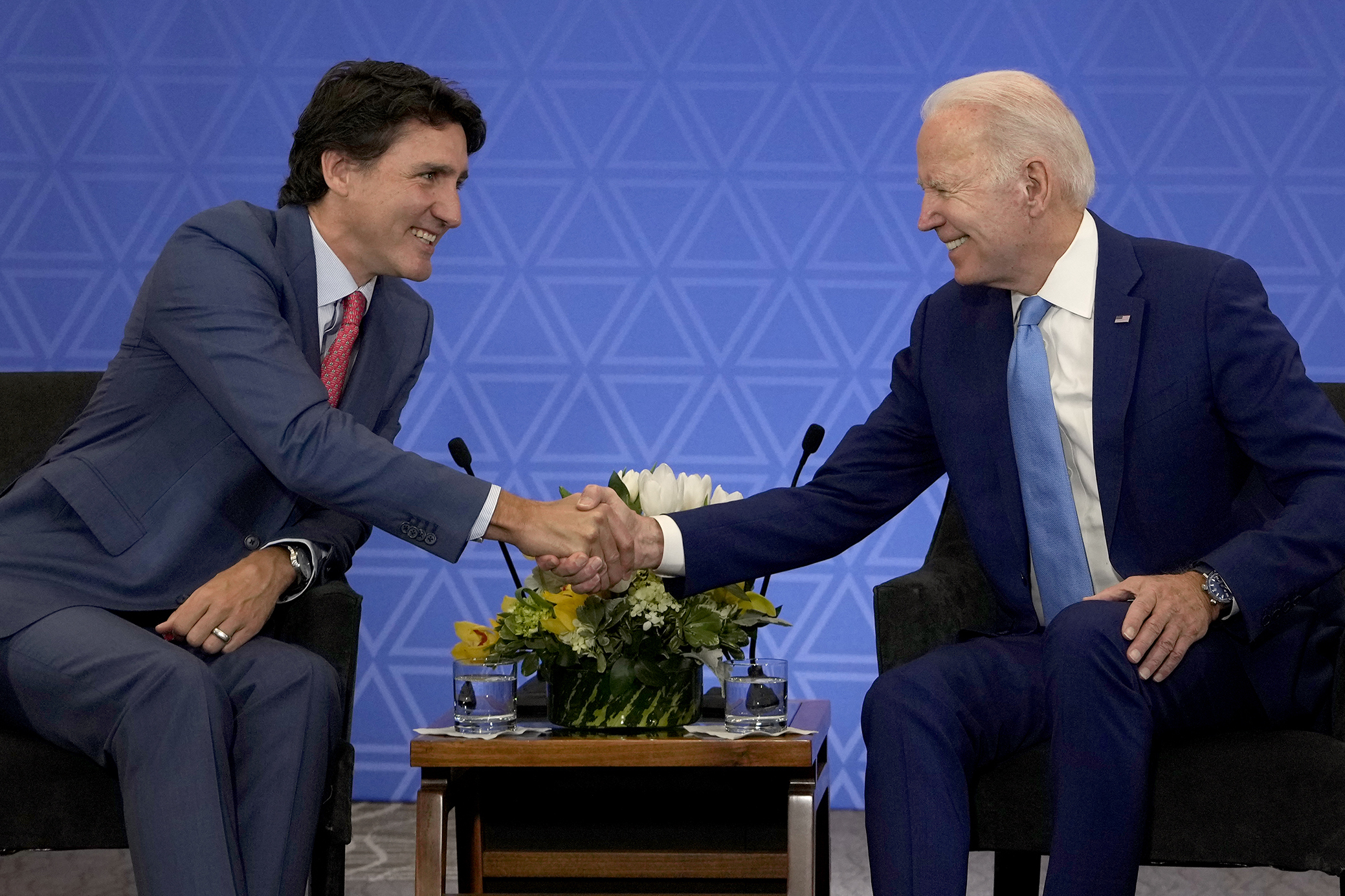There is a long-held belief in Ottawa of a tradition that a new president of the United States make Canada the destination of their first foreign visit.
President Joe Biden, however, will be making his first trip to Canada some 26 months after his inauguration. That is not to say President Biden and Prime Minister Trudeau, and their respective cabinet secretaries, ministers and officials have not been meeting, making announcements, and sharing constructive ideas and plans during this period, it’s just that in-person presidential visits to 17 other countries were a higher priority for the White House than Canada. Why is that? And more importantly – does the timing even matter?
Repairing the relationship
Since President Biden’s inauguration, Canada has been a very willing and capable partner with the Biden Administration on many fronts. For example, Canada was a crucial early ally as the United States re-engaged in the Paris Agreement, the international treaty on climate change originally adopted by 196 countries in December 2015, a top priority for the new administration. At COP 26 in Glasgow in 2021, Canada played a central role in helping the United States drive other countries to offer ambitious emissions targets, returning the U.S. to an international climate leadership role that had been abandoned by former President Trump.
When Russia launched the full-scale invasion of Ukraine in 2022, Canada’s Deputy PM and Finance Minister Chrystia Freeland’s championing of support for Ukraine, and her global leadership role in securing financial and economic sanctions against Russia, garnered broad appreciation and respect among D.C. decision-makers. At the G20 and G7 Summits in 2021 and 2022, PM Trudeau and President Biden and their teams sang from the same songbook – reflecting the deeply intertwined interests of the two North American partners.
In fact, in late February 2021, just a month after President Biden’s inauguration, the PM met with the president in D.C., and the two countries released the “Roadmap for a Renewed U.S.-Canada Partnership,” which documented the two countries’ alignment on everything – from accelerating climate ambition and leadership, fighting COVID, defence modernization and building global alliances, to creating secure supply chains (especially for critical minerals), “Building Back Better,” and advancing diversity and inclusion. At the conclusion of the meeting President Biden and PM Trudeau declared,
It is in the shared interest of the United States and Canada to revitalize and expand our historic alliance and steadfast friendship to overcome the daunting challenges of today and realize the full potential of the relationship into the future.
Canada has benefited enormously from the positive attention and engagement by President Biden and his administration, after four years of harmful bilateral policy and personal rifts incurred during the Trump Administration.
Canada and the IRA
Yet, despite the declarations of solidarity found in the February 2021 “Roadmap,” numerous challenges to a happy bilateral partnership have appeared in Biden administration policies. The United States’ industrial policy to attract investment and create jobs in America, via incentives in the 2022 “Inflation Reduction Act” (IRA) and its legislative predecessor, the 2021 “Infrastructure, Investment and Jobs Act” (aka the “Bipartisan Infrastructure Law”) are impossible for Canada to counter on a dollar-to-dollar basis. These incentives, combined with other advantageous factors in the United States, such as regulatory and permitting “nimbleness” and a lower cost workforce, have made it exceedingly difficult for Minister Freeland and her team to craft policy in the forthcoming budget to incentivize investments in Canada to create high value-add manufacturing here at home.
Another source of concern among Canadian policymakers were the EV consumer tax rebates proposed in the IRA, which would have provided U.S. consumers a rebate of up to US$12,500 if they purchased an American union-made electric vehicle. Canada argued this would be equivalent to a 34 per cent tariff on Canadian-assembled electric vehicles, and pointed out that the tax credit as proposed, would violate the U.S. obligations under the Canada-United States-Mexico Agreement on trade (CUSMA.) All of this prompted Canada to threaten retaliatory tariffs. Canada won that battle, but for Canadians who heard the “Buy American” rhetoric in the President’s 2023 State of the Union speech, it might appear that an array of new “protectionist” policies is right-around the corner. (Spoiler alert: “Buy American” policy is not the problem.)
Foreign policy priorities
On the countering China front, Canadian defence and foreign policy pundits – admittedly a not particularly influential voice in Canadian politics – expressed concern with the September 2021 United States, United Kingdom, and Australia (AUKUS) trilateral security pact for the Indo-Pacific region. The announcement came in the middle of the 2021 federal election and PM Trudeau was able to dismiss the agreement as a non-issue saying, “this is a deal for nuclear submarines, which Canada is not currently or any time soon in the market for, (but) Australia is.” Conveniently, this reaction avoided having to address the much more significant question of Canada’s ability to contribute to a broad allied Indo-Pacific strategy. Canada’s nascent strategy for the region was released in late November 2022 with CDN$721 million over five years target to, “invest in an enhanced military presence, along with intelligence and cyber security, to promote security in the region and ensure the safety of Canadians.”
Thus, the perception of Canada for President Biden is as a valued and helpful neighbour in most instances, as has typically been the case for most American presidents since Franklin Roosevelt.
But too often Canada is an after-thought.
Canada rises in prominence when the president and their senior officials have time to focus on the relationship, and that happens when Canada possesses an evident and useful set of solutions to bring to the table to help solve the president’s “problem”, typically those which are international in scope.
Canada is, of course, of much lesser utility in offering solutions to domestic U.S. political problems.
So, in their coming trip to Ottawa, President Biden and his cabinet-members will likely have one question in mind – how can the government of Justin Trudeau make the president’s “life” easier?
President Biden’s agenda
By all accounts President Biden’s life is not easy, on any front. With the biggest bank failure since 2008 just days behind him, he’s facing a challenging political environment at home as he heads toward a Republican-led debt-limit crisis in the summer, and the looming prospect of a recession ever-present (for which he will take the blame.) And that is just the beginning. The president is facing geopolitical tensions that are unparalleled since the Cold War circa the mid-1980s, with every sign that things will only get worse.
He is trying to navigate these issues while countering strong “anti-establishment” public sentiment that has contributed to a renewed decline in the trust the American electorate have in their elected and appointed officials, whether in the executive, the legislature, or the judiciary. President Biden’s challenges are exacerbated by a wildly polarized media ecosystem that is inflamed daily by punditry –sometimes informed and insightful, most times sociopathic – pumped out on absolutely every social media platform in existence.
As he makes his way to Ottawa later this week, reviews his briefing notes, and practices his remarks (“As Prepared for Delivery”) President Biden has a clear agenda: ensure PM Trudeau’s government is contributing to his administration’s objectives.
- The president’s team will want to see Canada contributing to a strengthened North American defence in a robust and sustained manner. Defence modernization is a theme the United States has pressed Canada on for decades. Russia’s invasion of Ukraine has forced the Canadian government’s belated recognition the country’s existing defence capability, procurement policy, and acquisition timelines do not represent a credible response to a profoundly changed international security environment.
The appointment of the former public services and procurement minister, Anita Anand, as minister of defence was coupled with the resolve to firmly establish national defence policy as politically significant and to set defence spending on a positive trend toward meeting NATO’s two per cent of GDP Wales Pledge. But much more needs to be done, and fast. - The president’s team wants to work with Canada on strengthened supply chain security, particularly in critical minerals. However, this aspirational goal runs into the reality of domestic vested interests on both sides of the border seeking to reduce competition, and zero-sum thinking. For instance, trade tensions persist between the countries over dairy, softwood lumber, and automobiles, the continent’s preeminent integrated manufacturing sector. In 2022, both Mexico and Canada challenged the US interpretation of automotive rules of origin (this is separate from the EV subsidy mentioned earlier.) The United States contended that “core parts” of the finished vehicle that require 75 per cent regional value content (RVC) to receive duty-free treatment under CUSMA cannot then be considered by default to be 100 per cent produced in North America for the calculation of the RVC for the finished vehicle. Canada and Mexico’s interpretation of the RVC calculation allows for the inclusion of more non-North American manufactured content in the finished vehicle while still qualifying for duty-free status. A preliminary CUSMA dispute panel ruling in January 2023 found against the U.S. interpretation. It favored Canada and Mexico’s position and will force the Biden administration into the politically vulnerable position of loosening its interpretation.
- The president’s team will continue to press Canada to play a leading diplomatic and security role in the western hemisphere, in Haiti in particular. In June 2022 in Los Angeles, PM Trudeau attended the ninth Summit of the Americas hosted by President Biden. Canada endorsed the United States’ Americas Partnership for Economic Prosperity, characterized by PMO as an effort “to tackle inequality and grow the economy and the middle class” in the region. An easy, “on-brand” commitment for the PM. But another more urgent ask was made of Canada in Los Angeles: to take a leading and forceful role in Haiti to quell the violent gang control of the nation and pave the way for a return to a semblance of peace and order to Haiti as it continues its long wait for good government.
The proposal by the United States that Canada lead a multinational police force intervention in Haiti was, however, conclusively shot down by PM Trudeau on March 15 when he stated, “outside intervention, as we’ve done in the past, hasn’t worked to create long-term stability for Haiti, so we are now working closely with partners on the ground to enable the Haitian National Police and other institutions to stabilize the country in this very difficult time.” Admittedly, Canadian capacity to pull off such an effort in Haiti is limited, not to mention potentially dangerous. Chief of the Defence Staff Gen. Wayne Eyre told media, “there’s only so much to go around.… It would be challenging.” Which brings us back to the need for defence modernization, probably the United States’ number one ask.

A matter of timing?
Does it matter that Biden is coming now, rather than in February 2021, shortly after his inauguration, as President Obama did in 2009? Well, no, the timing doesn’t matter. The bottom line is that President Biden’s visit to Canada halfway through his tenure, rather than at the beginning, tells us that he and his administration are comfortable and confident with the relationship between the governments and leaders. It tells us that when the two government leaders (and their ministers and officials) cross paths at the numerous multilateral fora, the two countries are engaged productively. They compare notes and work together, with the aim to achieve substantive benefits for both countries.
On the other hand, this generally low-key, neighbourly relationship with the Biden administration does not provide Prime Minister Trudeau with the leverage to insulate Canada from being the target of trade disputes or being sideswiped by domestic U.S. economic policy decisions. Nor does it mitigate negative effects for Canada by being the subject matter for U.S. domestic “political theatre” intended to harm the Biden administration. For example, the newly established “Northern Border Security Caucus” in Congress is raising concerns about the lack of security along the U.S.-Canada border.
In fact, both leaders are facing internal pressures from their respective legislatures on the issue of illegal migration along the northern border.
The Trudeau government has been put to task to address the migration issues and close the irregular border crossing at Roxham Road, between Vermont and the south shore of Quebec, by both the Quebec Premier François Legault and federal Conservative opposition leader Pierre Poilievre. With recent polls showing 68 per cent of Quebec residents, a key demographic for Trudeau’s re-election, wanting the irregular crossing closed. In the U.S., President Biden faces similar pressure from the Northern Border Security Caucus, but the southern border remains the primary focus of U.S. policy makers and critics. It’s not believed the issue will be on the agenda of any of the official working groups between the two delegations this week.
Canada will always have to contend with experiencing outsize effects on this side of the border of U.S. actions, the proverbial relationship of “sleeping with the elephant” as PM Trudeau’s father famously put it.
On the economic front, there will be no formal “agreement” between the two governments that will serve to reduce the flow of investment dollars going to the United States rather than to Canada. But as some economic commentators have recently noted, a wholly Canadian domestic response in Budget 2023 such as broadening tax credits and substantially increasing Canada’s “clean tech” finance capacity (well beyond the CDN$15 billion currently allocated to the Canada Growth Fund) could meet the competitive economic challenge from the United States, and still be within Canadian means.
Finally, with respect to Canada not getting caught in the crossfire of U.S. partisan political rhetoric and grandstanding, as we head toward the U.S. General Election of 2024, the Trudeau government can gain goodwill and mitigate the drift to being thought of as geopolitically irrelevant by making substantial investments in defence and placing even greater emphasis on hemispheric diplomacy. Tangible progress to advance critical mineral development and the transition to green energy will be an objective as well. Justin Trudeau, and Canada, will always have to contend with experiencing outsize effects on this side of the border of U.S. actions, as his father put it, “affected by every twitch and grunt” of the political situation in the U.S. but by taking the lead on issues where it can help to reduce the burden on our southern neighbours will go a long way to making sleeping with the elephant more comfortable.

Friday, March 24, 2023
12 noon ET / 9am PT
Join us this week for a live discussion of President Biden’s trip to Canada. Our panelists will discuss the state of the bilateral relationship and explore these questions:
- What are the United States’ top asks of Canada?
- What are Canada’s top concerns with regard to the relationship?
- How can the bilateral relationship be strengthened?
- What lies ahead in Canada-US dynamics headed toward the 2024 US general election?
